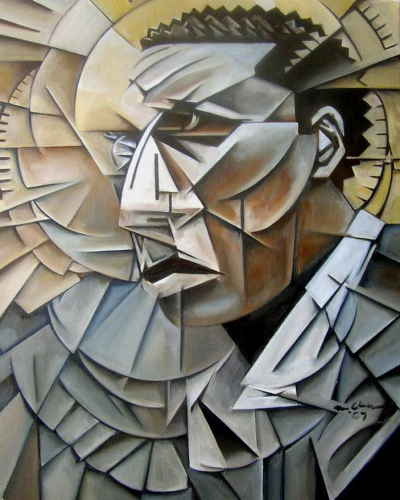.
.
“Last Trane” by Martel Chapman

,
.
Beyond Chains or Restraints
The Trane in full furious flight
releases a riptide of notes
the saxophone equivalent
of “Howl” by Allen Ginsberg
minds and hearts without chains
.
by Michael L. Newell
.
___
.
Trane
John Coltrane was the absolute
the decorated, the preternatural
and acknowledged master of what fury
can pour out of the body of a saxophone.
At club after club his finger tips
pressed down on the sax’s pads
so hard, so determined
that they turned white
bloodless-white, fiery coals.
Coltrane’s night songs
were as fluid, as full of rage
as fire is fluid and full
of an all consuming rage.
His hands were dexterous beyond the norm
brilliant. He seemed possessed
like some creature transported
down through the eye of time
from the Andromeda Strain
to bath himself in currents
at the mouth of one of our rivers
in autumn at an hour when stars
begin to poke through
and then send all of that back out
through the body of his sax.
Was there chaos?
There was a supreme chaos
at times controlled, at others
controlling— overcome
with random demolition.
Yet for all that, Coltrane
the admitted, the decorated master
was never able to bring his breath
to bear within his phrases
the way he wanted
the way he ached.
Never able to rest a beat
the way he felt it happen
in the awe-filled blackness
of his chest. That place
from which songs roar.
Never able to rest the way
any beast rests long and long
whenever they see an egret alone
bathed in current at a river’s mouth.
See an egret stand, untouched
as a coal that burns, that burns
even as clear water bathes it.
.
by Ed Ruzicka
.
___
.
It Was Coltrane’s First Soprano Sax
he imagined himself playing it maybe
in that underground railroad of a wind
blowing up South Michigan avenue
just had to have himself a piece
of what was already there
mapped out by his fingers
coded in his lips
couldn’t bust it open at first
sure the tunes came
but like doorbells ringing
when nobody’s home
wanted that tone in the upper register
that could outlast lungs
by ten dozen notes
wanted that sweetness
where air illuminates metal
buffs its shine
loops over and through
like a breathless knot
had to have it
got it
.
by John Grey
.
___
.
Naima
John Coltrane wrote a love song
dedicated to his first wife
after she helped him shed the shackles
of addiction to the bottle and the needle.
It features light-handed piano notes
laced through a plaintive description
by a saxophone of two people,
depleted by their traumatic lives,
woven together in a fabric that was
soon to begin unraveling.
The song is a jazz standard,
a lovely composition,
and a reminder of what can happen
when we choose to love.
.
.
by Laura Trigg
.
.
_____
.
.

Martel Chapman found artistic inspiration in Francis Wolff’s cover photograph of John Coltrane’s Blue Train album, and has been creating art honoring the artistic geniuses of jazz music ever since.
Click here to visit his website
.
.
___
.
.

John Grey is an Australian poet, US resident, recently published in New World Writing, North Dakota Quarterly and Lost Pilots. Latest books, ”Between Two Fires”, “Covert” and “Memory Outside The Head” are available through Amazon. Work upcoming in California Quarterly, Birmingham Arts Journal, La Presa and Shot Glass Journal.
.
.
___
.
.
.
Michael L. Newell lives on the Atlantic Coast of Florida. His most recent book of poems is Passage of a Heart.
.
.
___
.
.

The lightning-cracked pages of Ed Ruzicka’s third, full-length book of poems, “Squalls” (Kelsay Books), was released in March. Ed’s poems have appeared in the Atlanta Review, the Chicago Literary Review, Rattle, Canary and many other literary publications. Ed, who is also the president of the Poetry Society of Louisiana, lives with his wife, Renee, in Baton Rouge.
.
.
___
.
.
Laura Trigg is a retired physician currently living in Missouri and enjoying caring for her granddaughter while her parents are at work. A writer since childhood, she has had poems published in several journals, including Encore, Delta Poetry Review, Medicine and Meaning, Months to Years, and Jerry Jazz Musician.
.
.
Listen to the 1957 recording of John Coltrane performing “Blue Train,” with Kenny Drew (piano); Curtis Fuller (trombone); Lee Morgan (trumpet); Paul Chambers (bass); and Philly Joe Jones (drums) [Universal Music Group]
.
.
___
.
.
Click here to read The Sunday Poem
Click here to read “A Collection of Jazz Poetry – Spring/Summer, 2024 Edition”
Click here to read “Not From Around Here,” Jeff Dingler’s winning story in the 66th Jerry Jazz Musician Short Fiction Contest
Click here for information about how to submit your poetry or short fiction
Click here to subscribe to the (free) Jerry Jazz Musician quarterly newsletter
Click here to help support the ongoing publication of Jerry Jazz Musician, and to keep it commercial-free (thank you!)
.
___
.
.
Jerry Jazz Musician…human produced (and AI-free) since 1999
.
.
.

































